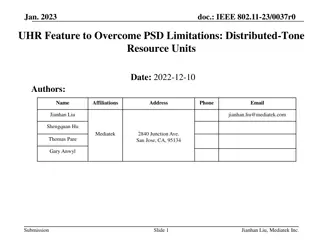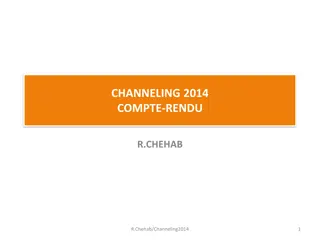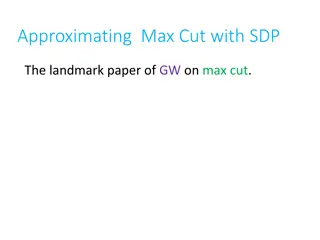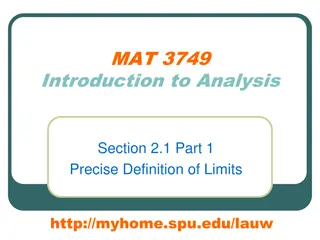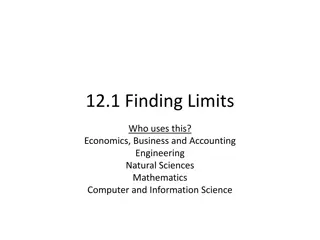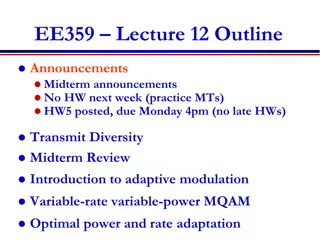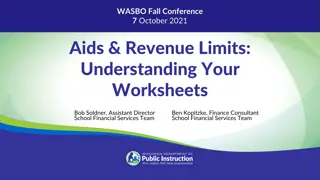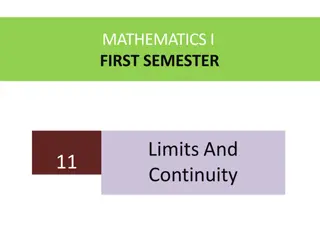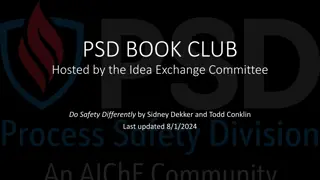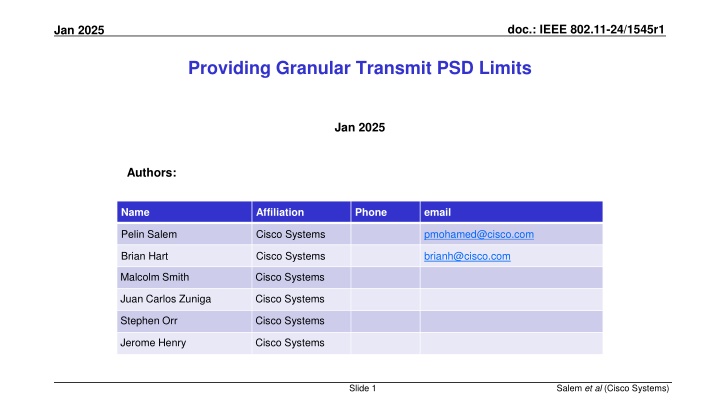
Granular Transmit PSD Limits for IEEE 802.11-24 Standard Revision
"Learn about the need for granular transmit PSD limits in the IEEE 802.11-24 standard revision to address issues with uneven AFC and client transmission power influence. Explore solutions for reporting PSD to clients at higher resolutions and ensuring compliance with regulatory requirements."
Download Presentation

Please find below an Image/Link to download the presentation.
The content on the website is provided AS IS for your information and personal use only. It may not be sold, licensed, or shared on other websites without obtaining consent from the author. If you encounter any issues during the download, it is possible that the publisher has removed the file from their server.
You are allowed to download the files provided on this website for personal or commercial use, subject to the condition that they are used lawfully. All files are the property of their respective owners.
The content on the website is provided AS IS for your information and personal use only. It may not be sold, licensed, or shared on other websites without obtaining consent from the author.
E N D
Presentation Transcript
doc.: IEEE 802.11-24/1545r1 Jan 2025 Providing Granular Transmit PSD Limits Jan 2025 Authors: Name Affiliation Phone email Pelin Salem Cisco Systems pmohamed@cisco.com Brian Hart Cisco Systems brianh@cisco.com Malcolm Smith Cisco Systems Juan Carlos Zuniga Cisco Systems Stephen Orr Cisco Systems Jerome Henry Cisco Systems Slide 1 Salem et al (Cisco Systems) -
doc.: IEEE 802.11-24/1545r1 Jan 2025 Executive Summary Situation AFC reports PSD/EIRP to AP at 1 MHz resolution then AP reports PSD/EIRP to STAs at a 20 MHz resolution, and/or AP reports PSD/EIRP to STAs at the PPDU BW resolution > 20 MHz Problem The AP cannot signal the regulatory PSD to STAs at a resolution below 20MHz. When AFC is uneven within 20 MHz (higher and lower PSD/EIRP segments present), AP reports the lowest value to STA, hence the client suffers when it transmits on a higher segment. Solution Enable the PSD/EIRP to be reported to the client at a higher resolution Slide 2 Salem et al (Cisco Systems) -
doc.: IEEE 802.11-24/1545r1 [Proxy ] AP Jan 2025 Situation AFC Architecture Overview: AFC System STA Land Cover Databases Regulatory Databases AFC Server Internet AFC reports PSD to AP at 1 MHz resolution AFC Request/Response Proxy, if present AP reports PSD to STA at 20 MHz resolution Beacon containing TPE elements SP APs AP1 Beacon containing TPE elements AP2 STA1 STA2 SP STAs Slide 3 Salem et al (Cisco Systems) -
doc.: IEEE 802.11-24/1545r1 Jan 2025 Situation AP triggers a client at an implied transmit power level, but the client might believe that power level is disallowed APs influence client transmission power in TB PPDUs via two fields in the Trigger frame: AP Tx Power field From which clients can determine pathloss UL Target Receive Power field Given this and the pathloss, a client can determine its TX power The client has minimum and maximum power limits for a given transmission: The transmit power of the HE TB PPDU is further subject to a STA s minimum and maximum transmit power limit due to hardware capability, regulatory requirements, and local maximum transmit power levels (see 11.7.5 (Specification of regulatory and local maximum transmit power levels)) as well as non-IEEE-802.11 in-device coexistence requirements (Page 4389, Section 27.3.15.2 Power precorrection, Draft P802.11REVme_D7.0) For an SP or Dual client in 6 GHz, the client obtains the regulatory requirements from its AP via Transmit Power Envelope (TPE) elements (see previous slide) Slide 4 Salem et al (Cisco Systems) -
doc.: IEEE 802.11-24/1545r1 Jan 2025 Example of the Frequency Response from a US-based test vector (FS19) Straddles LPI and LPI/SP spectrum UNII-5 UNII-6 UNII-7 UNII-8 5945 MHz 6425 MHz 6525 MHz 6875 MHz 7125 MHz 59 x 20 MHz (Beacon channels) 20 20 20 20 20 20 20 20 20 20 20 20 20 20 20 20 20 20 20 20 20 20 20 20 20 20 20 20 20 20 20 20 20 20 20 20 20 20 20 20 20 20 20 20 20 20 20 20 20 20 20 20 20 20 20 20 20 20 20 40 40 40 40 40 40 40 40 40 40 40 40 40 40 40 40 40 40 40 40 40 40 40 40 40 40 40 40 40 29 x 40 MHz 14 x 80 MHz 7 x 160 MHz 80 80 80 80 80 80 80 80 80 80 80 80 80 80 LPI or SP 160 160 160 160 160 160 160 320* 320* 320* LPI 3 x 320 MHz 320* 320* 320* 30 | 30 Incumbent bandwidth (MHz) 30 10 2.5 | 10 10 | 10 | 10 Key Often 13 dBm instead of 23 dBm -36.7 instead of 23 -35.4 instead of 23 -39.2 instead of 23 -33.4 instead of 23 PSD (dBm/MHz) 23 15.6 9.4 -24.2 -33.4 -36.7 -39.2 -40 80 MHz 80 MHz 80 MHz 80 MHz 80 MHz 80 MHz 80 MHz 80 MHz 80 MHz 80 MHz 80 MHz 80 MHz 80 MHz 80 MHz Slide 5 Salem et al (Cisco Systems) -
doc.: IEEE 802.11-24/1545r1 Jan 2025 Example of the Frequency Response from a US-based test vector (F50) Straddles LPI and LPI/SP spectrum UNII-5 UNII-6 UNII-7 UNII-8 5945 MHz 6425 MHz 6525 MHz 6875 MHz 7125 MHz 59 x 20 MHz (Beacon channels) 20 20 20 20 20 20 20 20 20 20 20 20 20 20 20 20 20 20 20 20 20 20 20 20 20 20 20 20 20 20 20 20 20 20 20 20 20 20 20 20 20 20 20 20 20 20 20 20 20 20 20 20 20 20 20 20 20 20 20 40 40 40 40 40 40 40 40 40 40 40 40 40 40 40 40 40 40 40 40 40 40 40 40 40 40 40 40 40 29 x 40 MHz 14 x 80 MHz 7 x 160 MHz 80 80 80 80 80 80 80 80 80 80 80 80 80 80 LPI or SP 160 160 160 160 160 160 160 320* 320* 320* LPI 3 x 320 MHz 320* 320* 320* PSD (dBm/MHz) Key 17 16.1 13.3 9.7 6.6 4 -3 dB -11 dB -10 dB -7 dB Slide 6 Salem et al (Cisco Systems) -
doc.: IEEE 802.11-24/1545r1 Jan 2025 Transmit Spectral Mask and Resolution Needs Using the 320 MHz channel as a use case, the concerned band is not only the 320 MHz region. We also need to focus on the side-lobes which could increase the band of focus to 960 MHz total. 320 MHz main lobe + 640 MHz skirts, Data bit-width is an important consideration. It should be able to accommodate even the largest bands such as this example. The method of compression is also very important consideration to use the channel effectively. Size of the contents is an important consideration to use an appropriate container. Slide 7 Salem et al (Cisco Systems) -
doc.: IEEE 802.11-24/1545r1 Jan 2025 Problem Statement In case of UL OFDMA, an AP assigns RUs of different sizes to its STAs In UNII-5/7, SP and Dual clients are allowed up to 17 dBm/MHz This can be lowered, sometimes extremely, by the AFC See examples for main lobe and side lobe impact below With 20 MHz- resolution TPE information, STAs can operate at sub-optimal power levels on many RUs With finer resolution, STAs can operate on more RUs and at higher powers However, 802.11 baseline+ amendments do not define a way to communicate the PSD levels at more granular level (RU < 20 MHz). In the same case If the STA s allowed power is constrained by the sidelobes of the TX PSD, STA can t take full advantage of the higher regulatory limits for the main lobes. Hence, again, STA operates at sub-optimal power levels and may not be able to make full use of the available PSD limits unless ... Regulatory PSD is reported at a finer resolution, more in line with RU sizes (~2 MHz). Currently, 802.11 baseline+ amendments do not define a way to communicate the PSD levels at more granular level depending on the STA preferences. 17 16.1 13.3 9.7 6.6 4 Current TPE contents (87.5% of RUs are crippled) 18 30 26 26 23 29 19 17 Clients current understanding of regulatory RU power limit (87.5% of RUs are crippled) 52 52 52 52 52 52 52 52 52 52 52 52 52 52 52 52 52 52 52 52 52 52 52 52 52 52 52 52 52 52 52 52 87.5% 52.8% x1.7 increase on the spectrum efficiency!! Proposed client current understanding of regulatory RU power limit (Now 62.5% of RUs are 52 52 52 52 52 52 52 52 52 52 52 52 52 52 52 52 52 52 52 52 52 52 52 52 52 52 52 52 52 52 52 52 crippled) Slide 8 Salem et al (Cisco Systems) -
doc.: IEEE 802.11-24/1545r1 Jan 2025 How to encode the information? (1/3) How many bits per power value to use? From earlier slides, allowed power can be exceedingly low (e.g., -23 dBm / 20 MHz) and may not need to be addressed Consider use cases for powers: Below -20 dBm / 20 MHz are unclear Between -20 and -10 dBm / 20 MHz are narrow (e.g., max density wireless docking) Between -10 and 0 dBm / 20 MHz are moderate (e.g., very high-density enterprise deployments) Above 0 dBm / 20 MHz is used widely Max power is 30 dBm / 20 MHz for SP/dual clients at 6 GHz Judgement call as to what range of powers and resolution we want to consider: Propose -10 to 30 dBm / 20 MHz aka -23 dBm/MHz to 17 dBm/MHz (for SP/dual clients) Propose 1 dB resolution (or finer, if more bits are trivially available) Then need to encode 41 values which is 6b min; could be 8b for simplicity (and finer resolution) (6b is still enough to support other values like -20 to -10 dBm too) Slide 9 Salem et al (Cisco Systems) -
doc.: IEEE 802.11-24/1545r1 Jan 2025 How to encode the information? (2/3) How to represent the change versus frequency? An array of values at 1 MHz resolution for a 320 MHz bandwidth (or more, for the skirts, or for the whole 1200 MHz band) has hundreds and hundreds of values too much From earlier slides, we see that the frequency response tends to be constant for a frequency range: Suggests considerable compression is available using run-length encoding See RHS snippet from the AFC message to the proxy / AP Sending the lowFrequency and highFrequency is duplicative; can be optimized away Recommendation: Define or send an initial frequency (e.g., define to be 5925 MHz; or send as 2 octets) Send multiple duples: - Frequency range (8 or 10 or 11bits) Value (6 or 8 bits) If the response is constant for > maxInt MHz, send multiple duples 1 octet requires a minimum of 5 duples to span 1200 MHz but 10 bits span 1024MHz { "frequencyRange": { "highFrequency": 5931, "lowFrequency": 5930 }, "maxPsd": 7.3426 } Parameter (Starting frequency) Number of duples First duple Second duple Value (and units) (5925) e.g.. 10 5 MHz 23 dBm/MHz 1 MHz 7 dBm/MHz Octets (2) 2 1 1 1 1 Interpretation at receiver 5925 to 5925+5=5930 at 23 dBm/MHz 5930 to 5930+1=5931 MHz at 7 dBm/MHz Slide 10 Salem et al (Cisco Systems) -
doc.: IEEE 802.11-24/1545r1 Jan 2025 How to encode the information? (3/3) How to represent the frequency resolution? The previous slide implicitly assumed 1 MHz resolution There are arguments for something different (e.g., 2 MHz or 5 MHz (or 0.5 MHz)) Either fixed or signaled as a further parameter 1 MHz seems like a reasonable choice; so other resolutions are for discussion / further study Parameter (Starting frequency) Frequency resolution Number of duples First duple Second duple Value (and units) (5925) 1 MHz e.g.. 10 5 MHz 23 dBm/MHz 1 MHz 7 dBm/MHz E.g.: 0 = 0.5 MHz 1 = 1 MHz 2 = 2 MHz Octets (2) 0.5 1.5 1 1 1 1 Interpretation at receiver 5925 to 5925+5=5930 at 23 dBm/MHz 5930 to 5930+1=5931 MHz at 7 dBm/MHz Slide 11 Salem et al (Cisco Systems) -
doc.: IEEE 802.11-24/1545r1 Jan 2025 How to signal this information? See examples in backup, we have example of this being upwards of 72 octets Too large for the beacon must be individually solicited Also, it doesn t change often (e.g., once per day) Need a container: e.g., Probe Request + Probe Response Define new Granular TPE Info element with Information field defined as the information in the previous slides A non-AP STA sends a Probe Request with the Extended Request element soliciting the Granular TPE Info element The AP responds with a Probe Response containing the Granular TPE Info element (etc) ANQP query Similar but define a Granular TPE Info ANQP-element and use the ANQP protocol instead Also need a way to alert recipients if the information has changed E.g., Use the critical update flag + a 2-3-4 bit counter in the UHR Operation element Slide 12 Salem et al (Cisco Systems) -
doc.: IEEE 802.11-24/1545r1 Jan 2025 Summary In case of UL OFDMA, although AFC reports PSD in 1 MHz resolution to the AP, AP reports TX PSD to the STA in > 20MHz resolution and STA operates at sub- optimal power levels and is not able to make full use of the available PSD limits. 802.11 baseline + amendments currently do not define a way to communicate the PSD levels at more granular level. We illustrate the problem using the AFC responses for US-based FS19 and FS50 test vectors. We then propose a framework to detail how to deal with this issue: Different bit lengths (4b / 6b / 8b) can be used based on the power ranges. The large amount of data can be encoded using run-length encoding (RLE) algorithm. Different frequency resolutions can be accommodated as signaled in the Granular TPE Info element we propose. The Granular TPE Info element can be signaled as a response to the Probe Request or in the ANQP-element. Slide 13 Salem et al (Cisco Systems) -
doc.: IEEE 802.11-24/1545r1 Jan 2025 Strawpoll Do you agree to add the following text to the 11bn SFD: 11bn shall define a mechanism for a non-AP STA to obtain granular regulatory transmit power limits? Y / N / A Slide 14 Salem et al (Cisco Systems) -
doc.: IEEE 802.11-24/1545r1 Jan 2025 Back-up Slide 15 Salem et al (Cisco Systems) -
doc.: IEEE 802.11-24/1545r1 Jan 2025 Transmit Spectral Mask and Resolution Needs Slide 16 Salem et al (Cisco Systems) -
doc.: IEEE 802.11-24/1545r1 Jan 2025 Example of the Frequency Response from a US-based test vector Slide 17 Salem et al (Cisco Systems) -
doc.: IEEE 802.11-24/1545r1 Jan 2025 Example of encoding octets for the US-based test vector (F50) Focusing on U-NII-5 band (5.925-6.425 GHz) and the U-NII-7 band (6.525-6.875 GHz): Number of transitions: 35 Number of unique values: 14 (-18, 1, 8, 9, 10, 11, 13, 15, 16, 18, 19, 21, 22, and 23) Total of 72 octets are needed to cover the entire UNII-5 and 7 bands for this test vector. U-NII-5 band (5.925- 6.425 GHz) Start Freq (MHz) U-NII-7 band (6.525-6.875 GHz) Start Freq (MHz) End Freq (MHz) Range (MHz) maxPSD (dBm/MHz) End Freq (MHz) Range (MHz) maxPSD (dBm/MHz) Octets Octets 5925 5940 15 23 2 6525 6580 55 23 2 5940 5951 11 10 2 6580 6590 10 22 2 5951 5959 8 23 2 6590 6610 20 23 2 5959 6020 61 -18 2 6610 6620 10 15 2 6020 6050 30 8 2 6620 6630 10 8 2 6050 6079 29 19 2 6630 6640 10 23 2 6079 6108 29 23 2 6640 6650 10 13 2 6108 6168 60 19 2 6650 6660 10 11 2 6168 6192 24 23 2 6660 6670 10 13 2 6192 6203 11 1 2 6670 6710 40 23 2 6203 6211 8 23 2 6710 6720 10 19 2 6211 6271 60 15 2 6720 6740 23 2 6271 6302 31 10 2 6740 6750 10 16 2 6302 6331 29 21 2 6750 6770 20 23 2 6331 6425 94 23 2 6770 6780 10 22 2 (*) Number of octets differ based on the number of unique values and transitions in the test vector. Each transition is expected to require 2 octets, one for frequency and one for EIRP/PSD reporting. 30 6780 6790 10 13 2 6790 6800 10 23 2 6800 6810 10 13 2 6810 6820 10 10 2 6820 6830 10 1 2 6830 6875 45 23 2 42 Slide 18 Salem et al (Cisco Systems) -


